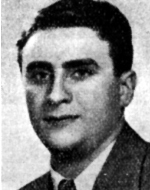Shmuel, the son of Deborah and Zvi-David (Hersh), was born in Lodz in 1925. He was a member of the Amelim family and attended a public school and from a young age took part in the burden of supporting the household. He was a young boy who joined the Gordonia movement in his city, and on the eve of World War II, Poland was the focal point of world Jewry in the fields of religious, national, political, social and cultural activities, 225,000 Jews, the second largest community after Warsaw, the Jews of Lodz contributed greatly to the development of the city, apart from the establishment of many industrial enterprises It was also an important Jewish cultural center, where a network of Jewish schools was built, great intellectuals worked in it, and political and public activity was waged among its members.The Germans occupied Poland in September 1939. Immediately after that, About 70,000 Jews, many of whom fled voluntarily to the east, to the areas controlled by the Soviets, and the ghetto was closed in April 1940 and some 200,000 Jews were crammed into inhuman conditions. The Jews of the ghetto were exploited as cheap labor and forced to work in production plants for the Germans. The ghetto soon became a site of mass mortality: overcrowding and poor sanitary conditions caused epidemics, and the population suffered from starvation and starvation. During 1942, about 80,000 people were deported from the ghetto to extermination camps, mainly to Chelmno. The Lodz ghetto, which was the last to be held in Poland, was liquidated in the spring of 1944. For this purpose, the Chelmno extermination camp was reopened, and Jews were deported under the guise of deportations to labor camps in Germany. From August 1944 all the remaining Jews were deported to the Auschwitz death camp. By the end of the war almost all the Jews of Lodz had been murdered. Their fate was the fate of 90 percent of Polish Jewry. Shmuel and his family were among the inmates in the Lodz ghetto. Every day Shmuel went to work in the labor camp, and even in camp conditions he knew how to preserve his human image and was always willing to help anyone who failed. He was later transferred to the Auschwitz death camp, where he was privileged to see the liberation. His family perished in the camp. At the end of the war he was one of the first to join Aliya Bet, which was operated by emissaries of the Haganah from Palestine. On August 2, 1946, Shmuel boarded the illegal immigrant ship “23 Yordei Ha-Sira.” The ship, which was organized by the Mossad Le-Aliyah Bet of the Hagana, sailed from the port of Boca di Magra in Italy with 790 immigrants from Eastern and Central Europe, And a British destroyer took over the ship and towed it to the port of Haifa.The immigrants began a hunger strike in protest against their expected deportation, but after a violent struggle they were forcibly loaded onto a British ship and taken to camps in Cyprus. In the detention camp in Cyprus, Shmuel arrived in Israel in early 1947. He settled in Tel Aviv and had a laundry in the street Yehuda Halevy At the outbreak of the War of Independence, Shmuel was one of the first recruits to serve in the 13th Battalion of the 1st Brigade, the Golani Brigade, and was a partner in the battalion’s battles since the beginning of the war, especially in the south. I think there is no generation in the history of our history that has gone through what our generation is going through, but this time too we must stand up and defend our dignity. In December 1948, Shmuel participated in Operation Horev (Operation Horev) (also known as Operation Ein, Gaza, Auja, Asluj) at the end of 1948, designed to repel The Egyptian army from a straight lineTo the south. In which the Golani Brigade was tasked with creating a deception in the western wing of the front, before the main effort in the eastern wing began. On the night of 22/23 December 1948, the brigade captured the 86th post north of Khan Yunis, threatening the road and the railway, creating the impression that the intention was to create a disconnect between the Egyptian forces in the Gaza Strip and Sinai. The Egyptians reacted with an attack on Gaza with the help of artillery and armor, and under the pressure of the enemy the Golani fighters were forced to retreat. In this battle, on the 23rd of Kislev 5709 (23.12.1948), Samuel fell. Shmuel was twenty-three years old when he fell. Was buried in the borders. On the 16th of Av 5709 (August 11, 1949) he was transferred to eternal rest in the Nahalat Yitzhak Military Cemetery. Despite the failure of some of the plans of Operation Horev, its main objective was achieved, the Egyptians remained trapped in the “Faluja pocket” and at other points were forced to retreat. At the beginning of January 1949, Egypt announced its readiness for a cease-fire, thus ending hostilities on the southern front. Space is a “last scion”. The survivors of the Holocaust are survivors of the Holocaust who survived the last remnant of their nuclear family (parents, brothers, sisters, sons and daughters) who experienced the Holocaust in the ghettos and / or concentration and extermination camps and / or in hiding and hiding in territories occupied by the Nazis and / Or in combat alongside members of the underground movements or partisans in the Nazi-occupied territories who immigrated to Israel during or after World War II, wore uniforms and fell in the Israeli army
